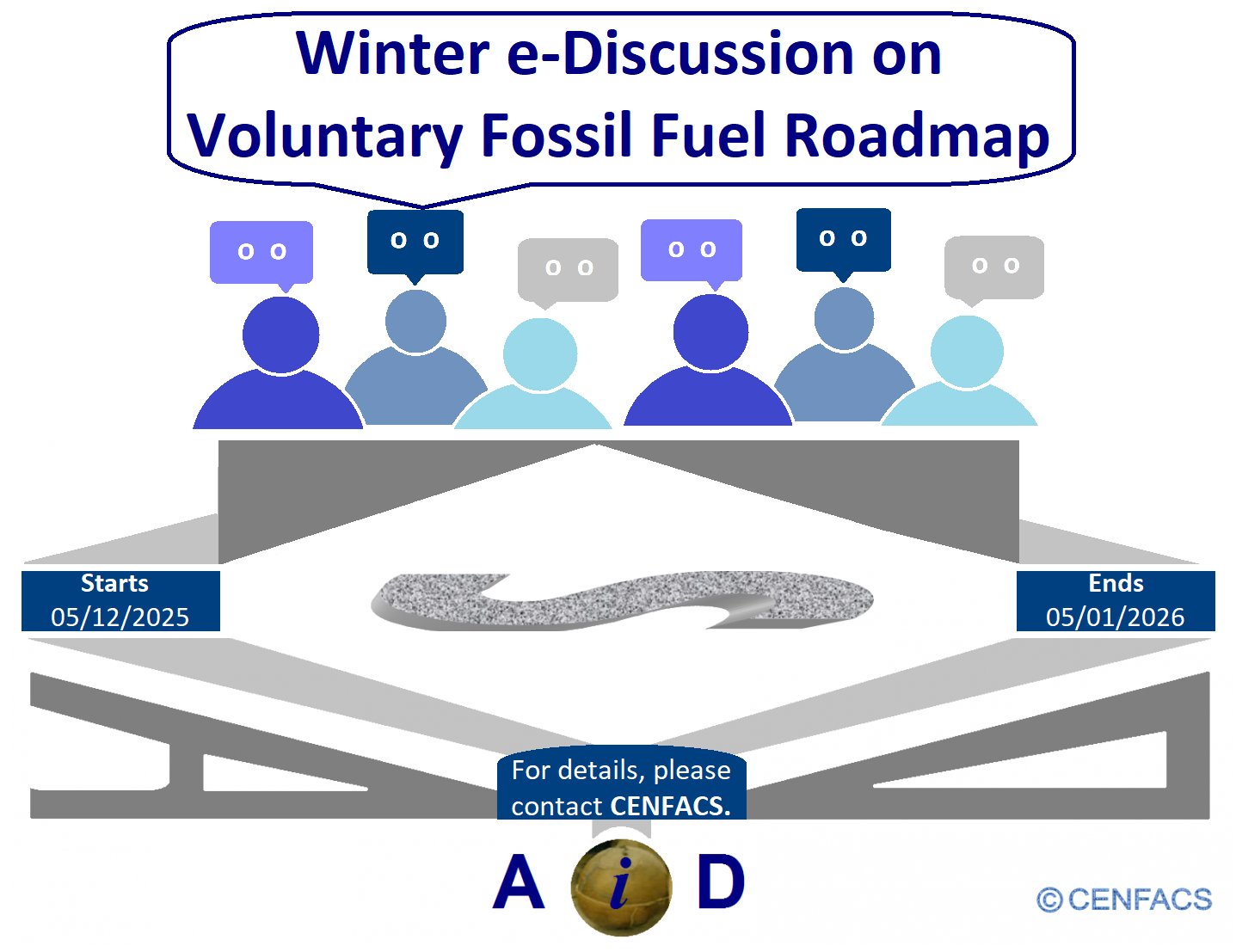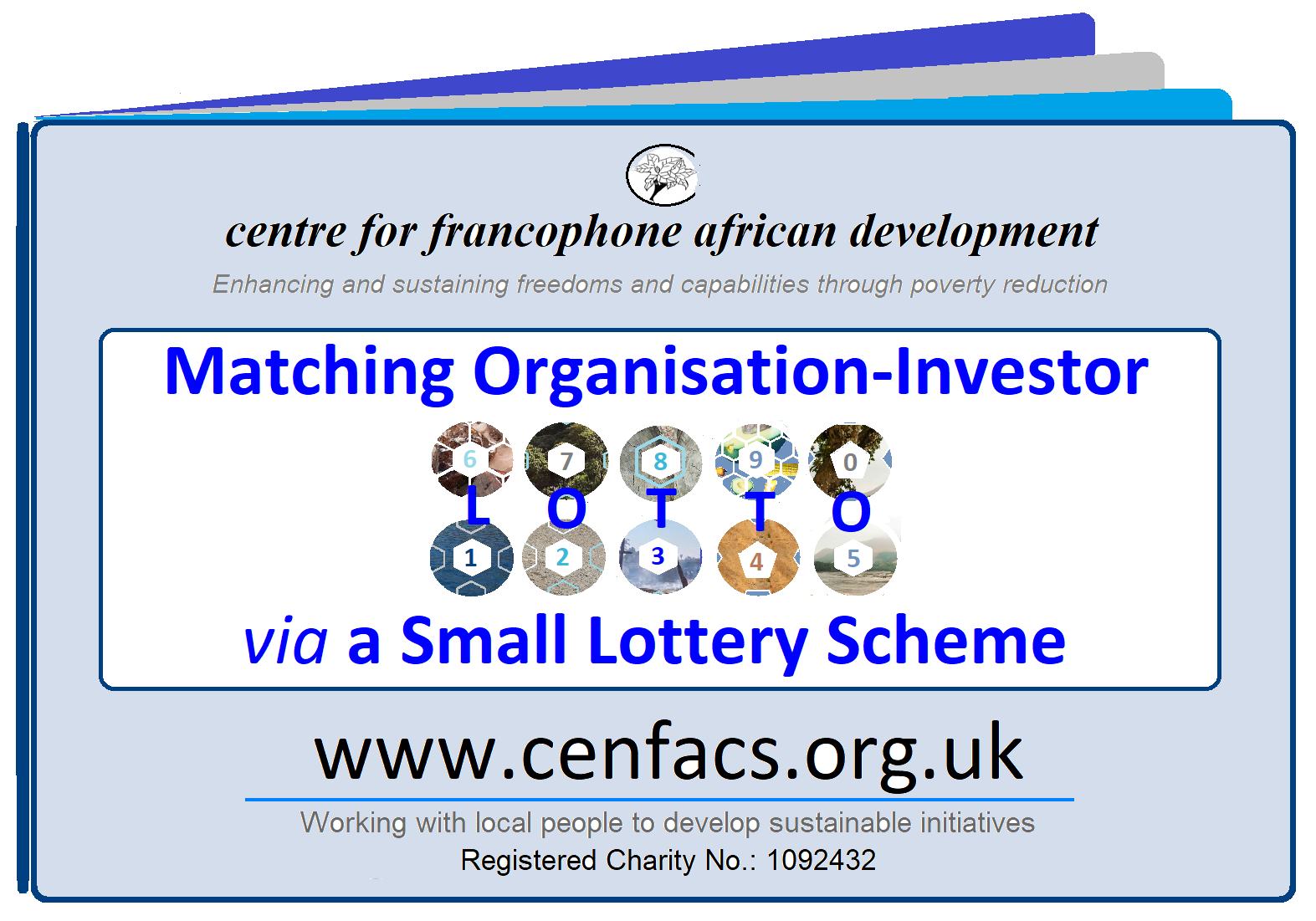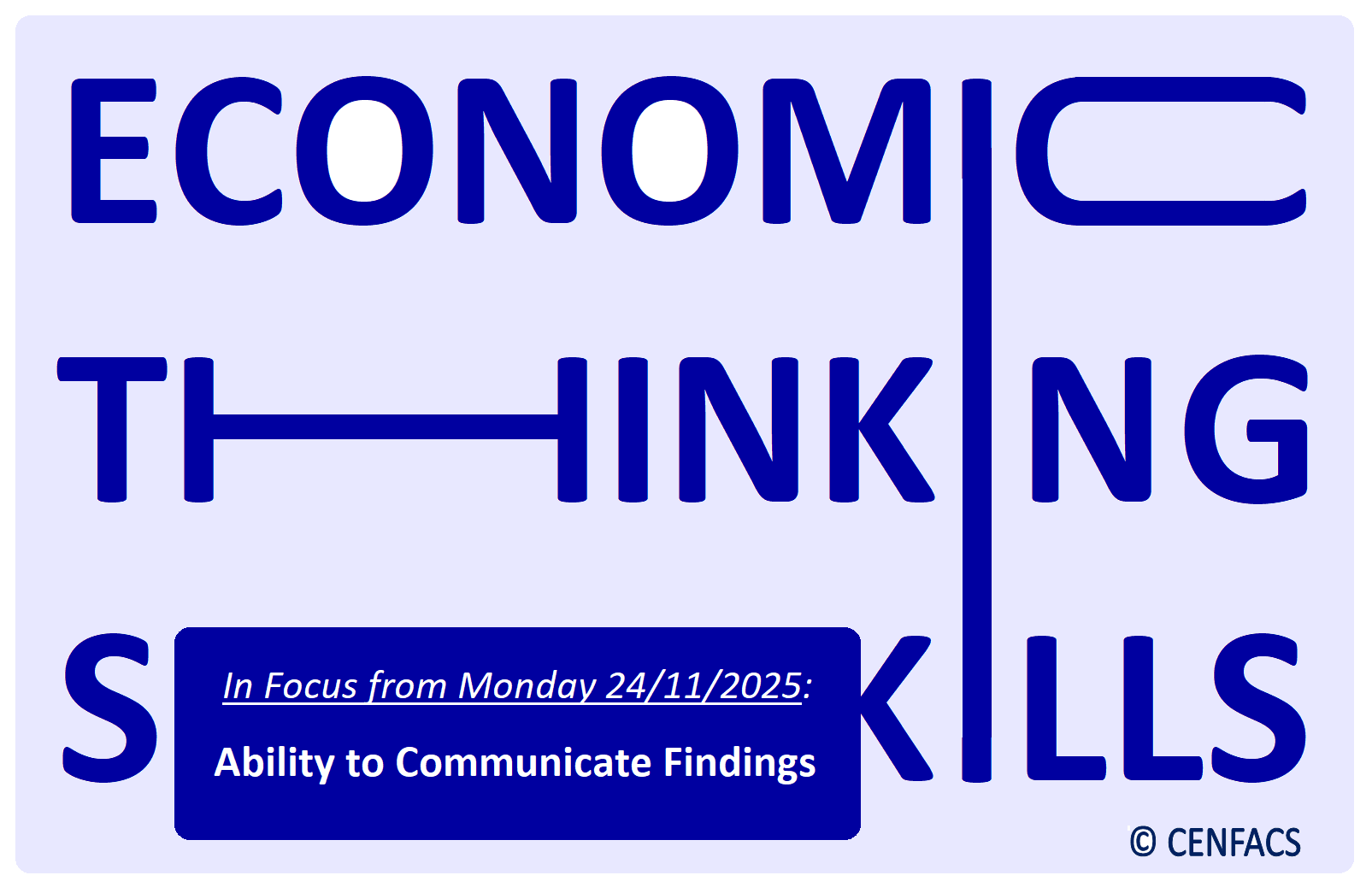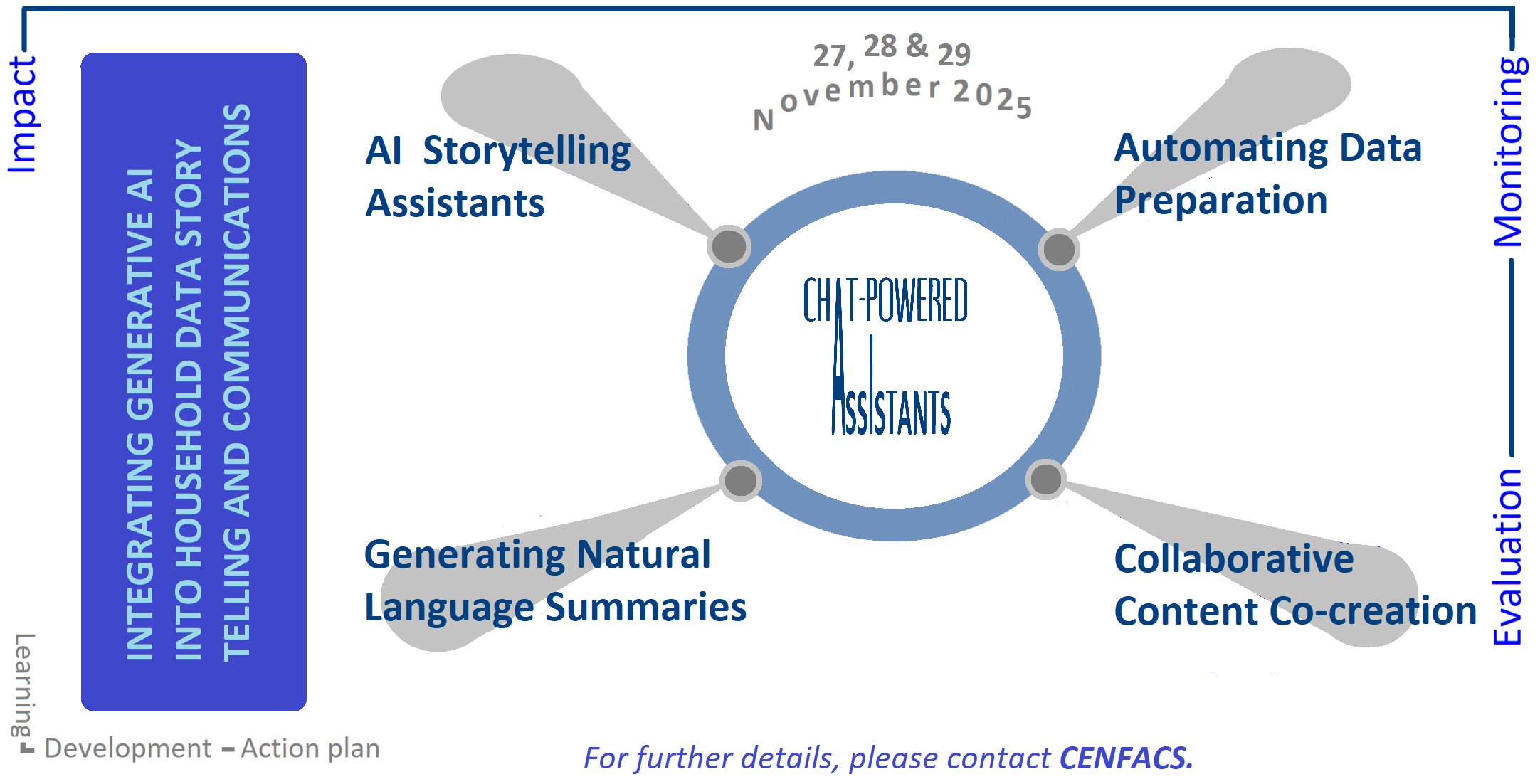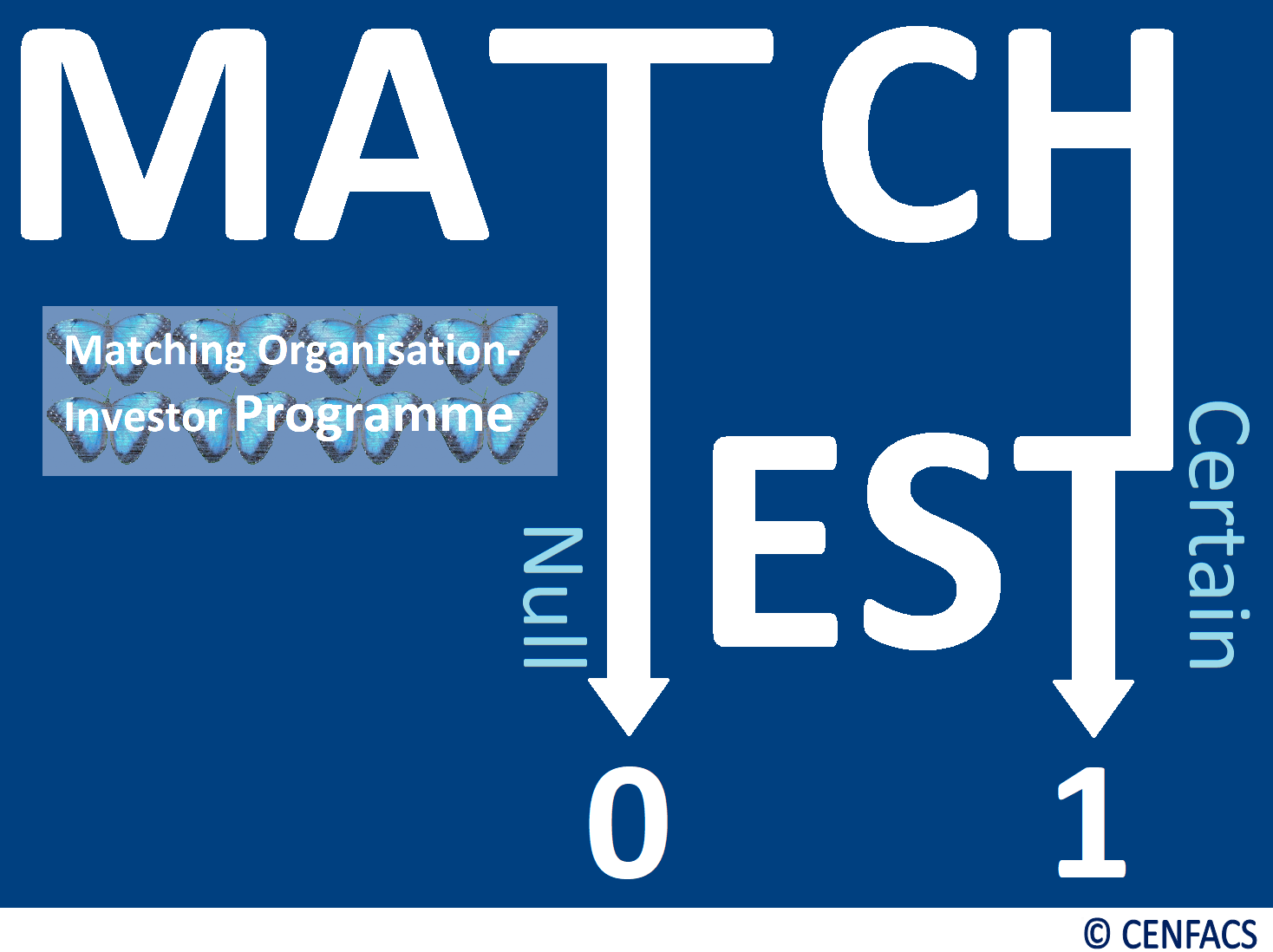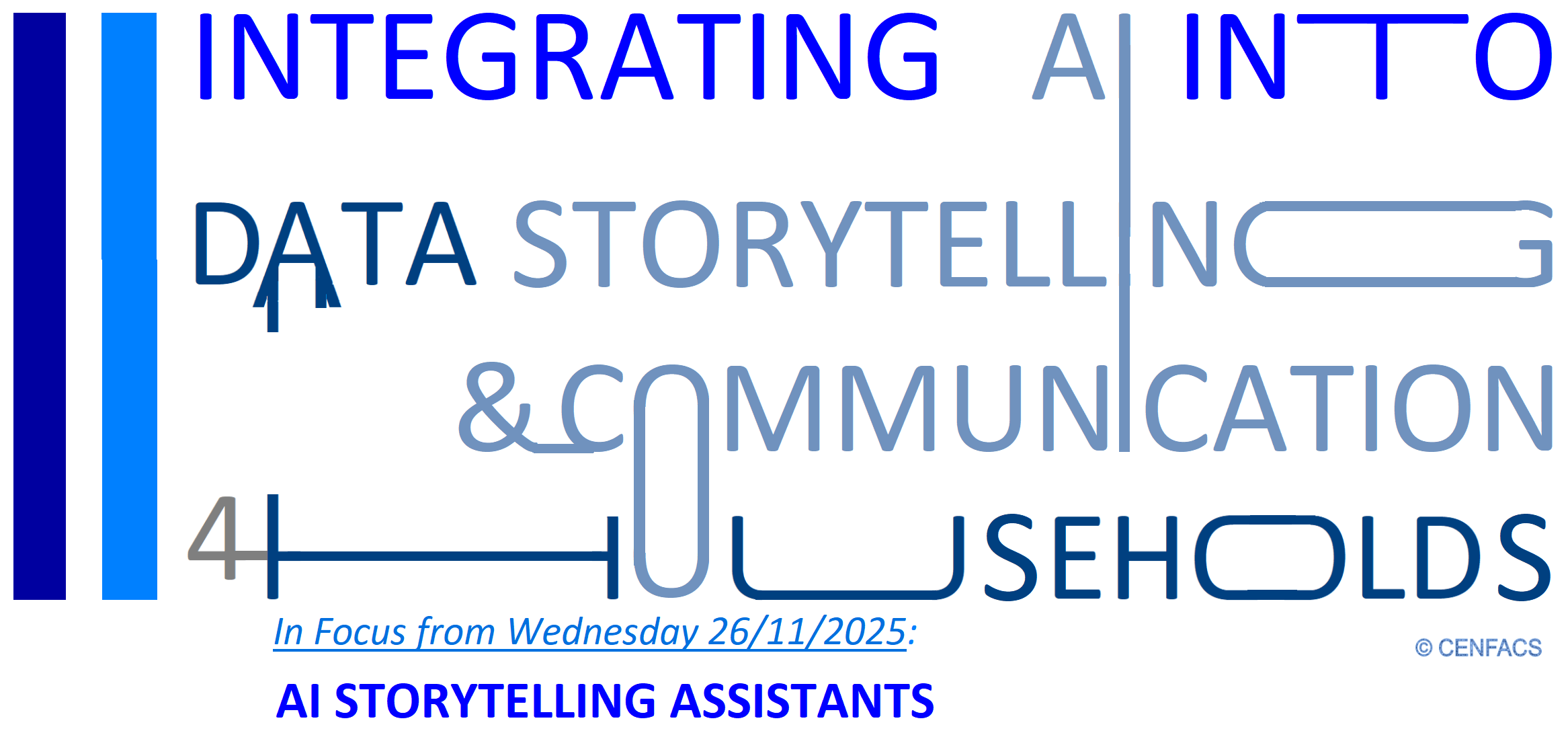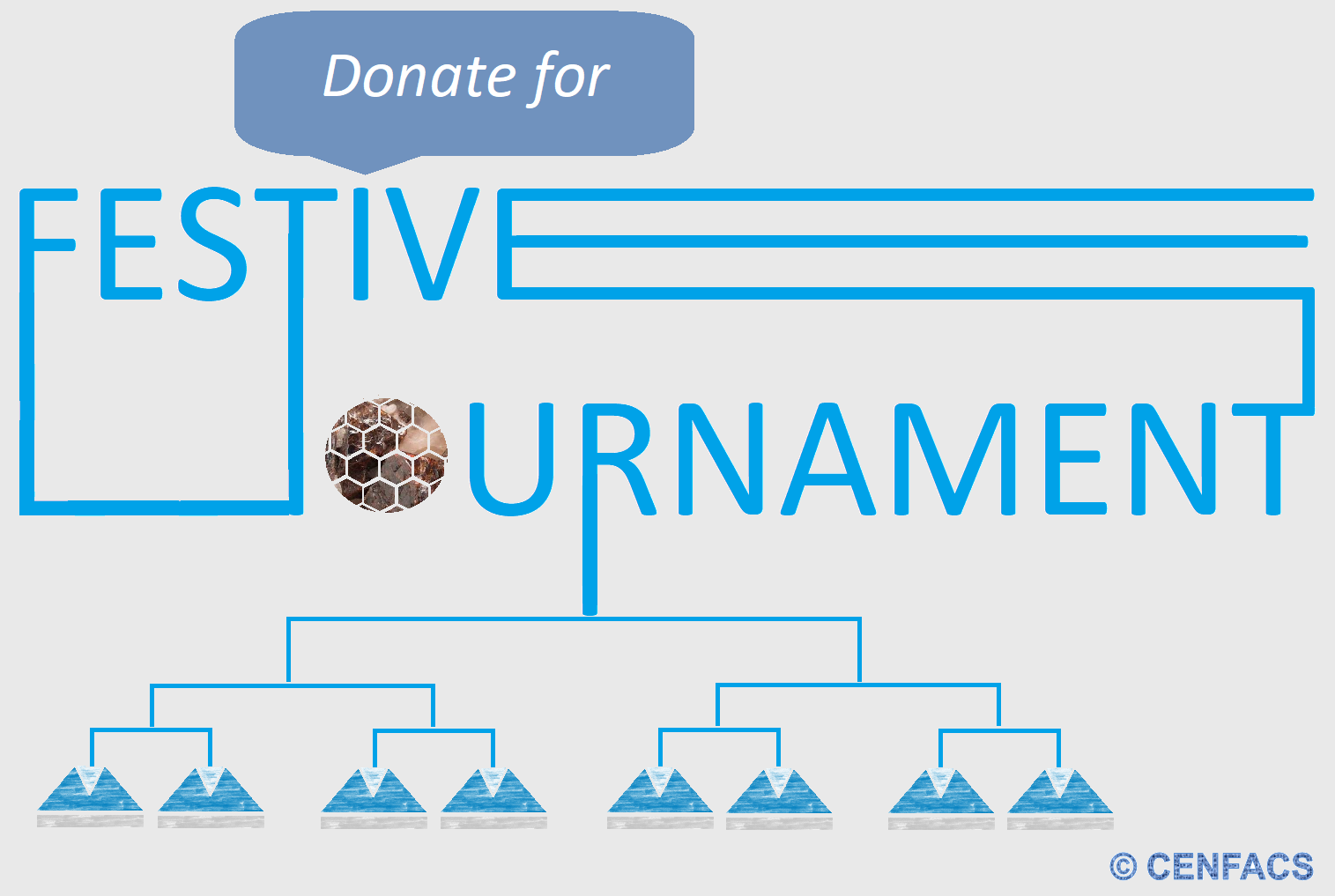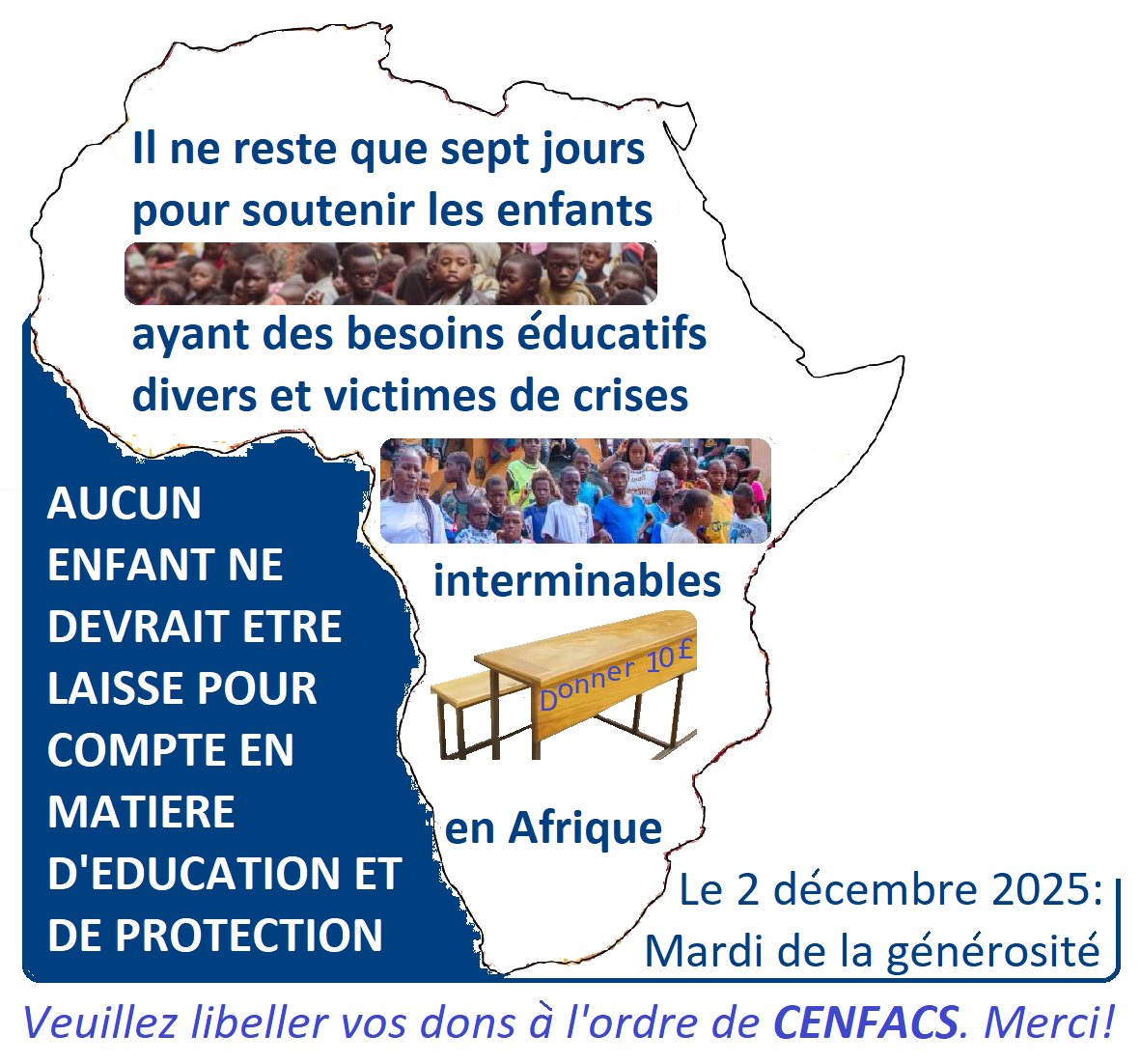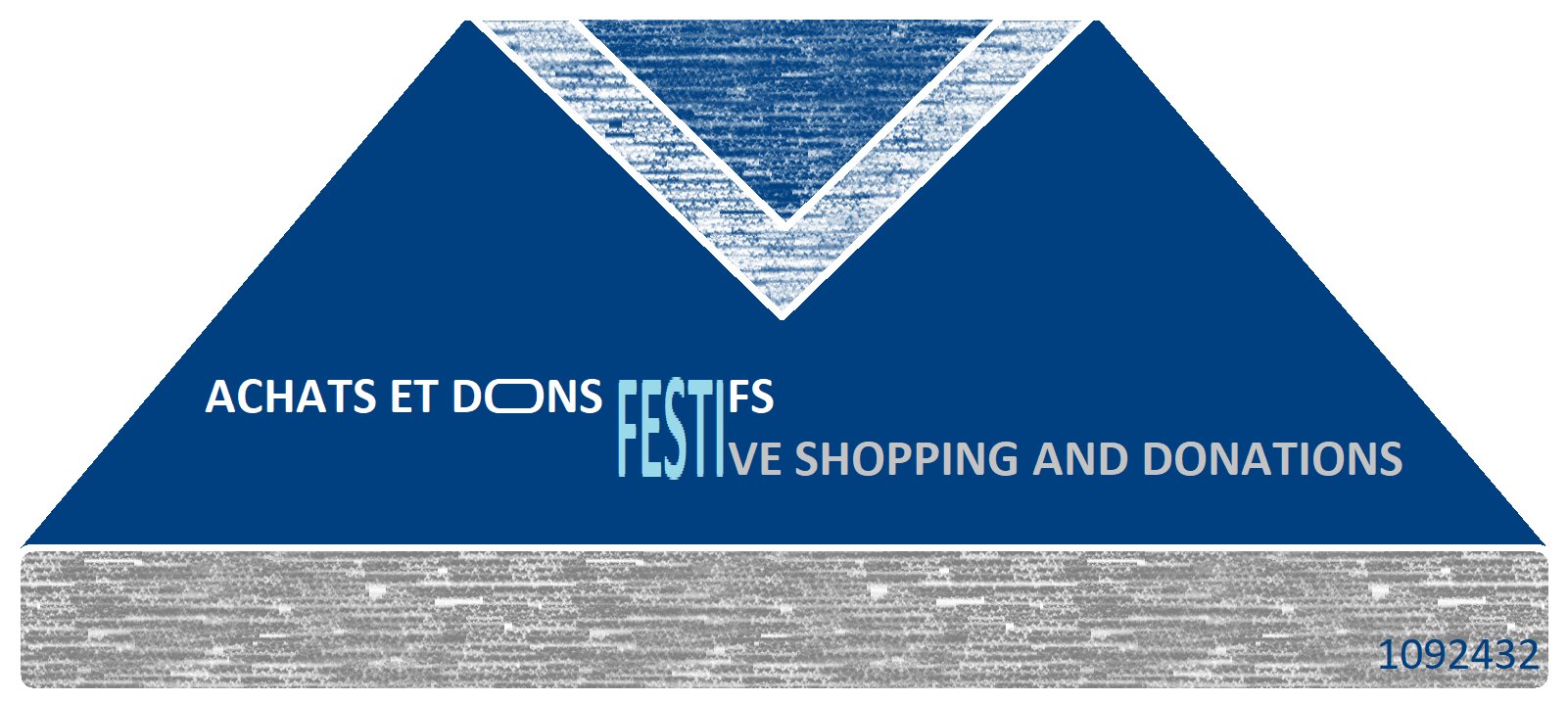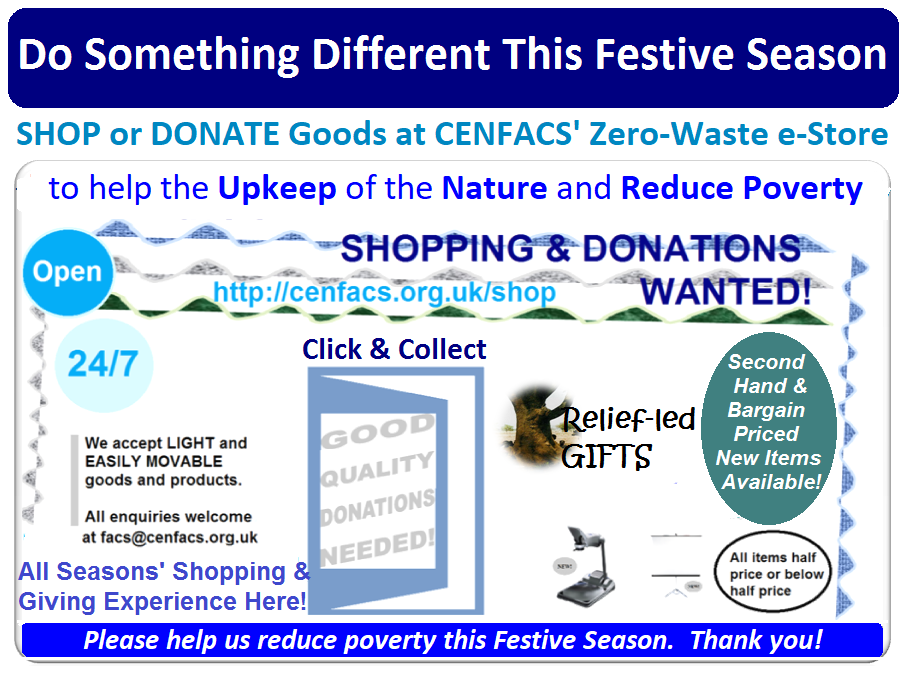Welcome to CENFACS’ Online Diary!
26 November 2025
Post No. 432
The Week’s Contents
• Making Donations with Festive Shopping
• Autumn Matching Organisation-Investor Programme via a Small Lottery Scheme
• Economic Thinking Skills or Economics Skills Development – In Focus from Monday 24/11/2025: Ability to Communicate Findings
… And much more!
Key Messages
• • Making Donations with Festive Shopping
Please support CENFACS to help others this Giving Season by generating donations when you shop.
As the Festive Season’s preparation has started, anyone can help raise funds for CENFACS through their charitable shopping without giving any penny. It does not cost them any money to give to charities like CENFACS while shopping, whether online or in-person, and being asked either to tick a box or to name or choose a charity to benefit from their festive shopping activities.
You can turn your Festive Shopping into Donations to CENFACS.
By ticking a box to donate to charity or naming or choosing CENFACS, they can enable CENFACS to receive no-direct cash donations from their shopping; donations which we need to help those suffering from poverty and the lingering effects of the cost-of-living crisis.
Please remember that around the festive period millions of shoppers do not claim their points, discounts and rewards. These points, prizes and rewards could have gone to good causes like CENFACS‘ noble and beautiful ones.
The amount of unclaimed points, prizes and rewards by festive shoppers can be significant. In 2010, Loyalty Magazine (1) wrote this:
“There are £5.2 billion worth of unused loyalty card points on UK cards, according to a new report by the Subway fast food chain”.
Likewise, Grocery Trader (2) stated in 2022 that
“The convenience retailer [Coop] said over 4 million of its members in the UK had accumulated £25 million in unspent member rewards, which can be used as an extra cash boost this Christmas. With 73% of Brits having at least one grocery loyalty card, but with only 1 in 5 (20%) checking them weekly and 1 in 10 (10%) never checking how much their cards are worth, there is an estimated £1 billion plus of points and rewards sitting unused across the UK”.
These accumulated loyalty-point liabilities can help good causes, like CENFACS‘ noble and beautiful ones. They can be turn into assets for good causes.
So, it does not cost you as a festive shopper anything if you tick a box or name or choose CENFACS as your favourite charity to receive your points, prizes and rewards which could otherwise become unclaimed, unused and wasted.
This festive season, please do not let these free offers resulting from your festive shopping go unclaimed or wasted. CENFACS wants them. CENFACS needs your loyalty shopping points, discounts, vouchers, prizes and rewards that you do not want or need.
We need them to help people living in poverty and hardships. These people require them. We are demanding your no-direct cash gift and support through your festive shopping to help them.
Please support CENFACS raise donations for its cause when you buy gifts, decorations, festive items and everything else.
You could help generate donations for CENFACS when you shop this Festive Season. CENFACS would deeply appreciate if you could inject meaning into festive consumerism by helping its noble and beautiful cause of poverty reduction.
Would you mind ticking a box or naming or choosing CENFACS to benefit from your festive shopping activities?
More on ways of supporting CENFACS’ beneficiaries through your festive shopping as well as CENFACS’ Festive Shopping and Donations Project is given under the Main Development section of this post.
• Autumn Matching Organisation-Investor Programme via a Small Lottery Scheme
This Autumn, we have another appealing project from our Matching Organisation-Investor Programme; programme which is part of CENFACS’ Guidance Service to not-for-profit impact investors. What is this appealing project about?
• • Brief Explanation of a Small Lottery Scheme (SLS)
SLS will help to raise funds for a non-commercial purpose. This is all part of working with Africa-based Sister Organisations to find alternative income streams to continue their mission of reducing poverty in Africa. The scheme is from an African Poverty Relief Charity to attract support from people who may not make donations if there is not an incentive for giving by offering them a prize in return for a contribution.
To better understand the matching process surrounding this SLS, let us provide the matching statement, APRC’s plan for a SLS Development, the qualities (or person specification) of the not-for-profit impact investors APRC is looking for, the aim of this matching exercise, the definition of matching organisation-investor through a SLS, the duration of matching activities, and the way this matching project will be run.
• • Matching Project Statement
The project is a matching opportunity between an African Poverty Relief Charity (APRC) and a prospective investor who may be interested in impact investing in APRC’s plan. The project is the following one:
APRC is planning to develop a charitable lottery scheme whereby funds generated will be used to benefit local poor people. APRC, with its plan and legal documents, will apply to the relevant commission or authority in African countries where the scheme will be implemented.
The above project statement is also APRC’s business model. To better understand this project, let us explain APRC’s plan for a lottery scheme development and not-for-profit investor’s motivations.
• • APRC’s Plan for a Small Lottery Scheme Development
It is a set of activities to set up a prize draw for charitable purposes. The plan, which will have a non-commercial purpose, will be registered and have financial limits (e.g., the ceiling in terms of the proceeds of a single lottery which will not exceed some amount), proceeds for distribution, ticket regulations, and responsible gambling (for instance, all ticket purchasers and sellers must be at voting age or beyond). In other words, it will include the setting up of the prize and ticket values, the provision of details for the draw process, the planning of ticket sales and distribution, and the determination of the prize pool and expenses.
To be able to move forward its plan, APRC is looking for a not-for-profit investor to join in by investing with a capital. APRC is particularly seeking investment from a not-for-profit investor interested in small lottery schemes or activities.
• • What Is a Not-for-profit Investor in Small Lottery Schemes or Activities?
A Not-for-profit Investor in Small Lottery Schemes or Activities is a person investing in lottery activities or businesses by lifting them out poverty and hardships. The n-f-p investor, who is driven by selfless motivations, would invest to reduce poverty. Although he/she is driven by selfless motivations, he/she would like to see the small lottery scheme or activity is a profitable business so that it can achieve its goal of reducing poverty by raising money for it through lottery process.
As part of CENFACS‘ model of Matching Organisation-Investor Programme, the n-f-p investor’s selfless motivations will be match with APRC’s plan.
• • What Is Matching Organisation-Investor via a Small Lottery Scheme?
It is a set of three activities designed to arrange the match/fit test between an APRC’s plan to develop a small lottery scheme in Africa and a prospective not-for-profit impact investor’s interests in lottery activities in Africa. This project of CENFACS’ Matching Programme will enable the former to find a suitable investor, and the latter to gain an investee in which they can impact invest in.
• • The Aim of Matching Organisation-Investor via a Small Lottery Scheme
The main aim of this project is to reduce poverty through the development of a small lottery scheme in Africa.
Through this project, it is hoped that the APRC will meet its dream not-for-profit (n-f-p) impact investor. It is as well expected that the n-f-p impact investor will find the right organisation to invest in for impact. Where the two parties experience difficulties in matching their project proposals or ambitions, CENFACS will organise the match test for them. To enable the two parties to reach an agreement, there will be three weeks of talks or negotiations or matching activities.
• • 3-week Matching Activities Starting from 01/12/2025
As part of CENFACS‘ Matching Organisation-Investor via a Small Lottery Scheme, we are running a 3-week period of matching activities to support both APRC and not-for-profit lottery investors. It is a 3-week work about Impact Advice Service for APRC and Guidance Service on Impact Investing for not-for-profit lottery investors.
• • • How the Matching Process Will Be Run
This talking process is based on lottery project life cycle. There are various types of lottery project lifecycle with their own steps or stages. In the context of this project of our matching programme, we have limited ourselves to a three steps/stages model of lottery project lifecycle.
The above is the key note of the Matching Organisation-Investor via a Small Lottery Scheme.
Those potential organisations seeking investment to realise their small lottery project and n-f-p lottery investors looking for organisations that are interested in their capital can contact CENFACS to arrange the talks and match or fit test for them. They can have their fit test carried out by CENFACS’ Hub for Testing Hypotheses.
For any queries and/or enquiries about the Matching Organisation-Investor via a Small Lottery Scheme, please do not hesitate to contact CENFACS.
• Economic Thinking Skills or Economics Skills Development – In Focus from Monday 24/11/2025: Ability to Communicate Findings
To approach this fourth skill – that is, the Ability to Communicate Findings – we have organised our notes as follows:
σ What is Ability to Communicate Findings in the context of economic data?
σ How helpful the Ability to Communicate Findings is
σ Economic communication skills that households need to communicate findings
σ The areas where CENFACS can work with the community members to develop their economic communication skills
σ Summary of the Economic Education Month Activity of the Week
σ Last thought about Economic Thinking Skills or Economics Skills Development for Households.
Let us look at each of these items.
• • What Is Ability to Communicate Findings in the Context of Economic Data?
It is about communicating economics, according to ‘economicsnetwork.ac.uk’ (3).
Indeed, the ability to communicate findings from economic data is essential skill for households to see beyond the numbers and make informed decisions. It is about strong written and verbal communication skills to improve decision-making and ultimate outcomes as well as creating effective data visualisation.
• • How helpful the Ability to Communicate Findings Is
It helps to turn data into insights that drive better household decisions. Households need to clearly and persuasively convey their findings, tailoring their messaging to different audiences to ensure both financial (specialist) and non-financial (non-specialist) people understand the impact of numbers.
• • Economic Communication Skills that Households Need
Economic communication skills are essential for conveying complex economic concepts, analysis, and research findings to various audiences.
These skills include the following:
~ Clear and concise language: Using plain language and avoiding jargon to make economic concepts understandable to both experts and non experts;
~ Adaptability: Adjusting the level of technical detail and tailoring the message to the audience’s background and interest;
~ Storytelling: Presenting data and analysis with a narrative framework to create a compelling context;
~ Visual presentation: Utilising visual aids like graphs, charts and infographics to enhance clarity and impact;
~ Active listening: Paying attention, asking clarifying questions, and appropriately responding to ensure effective communication.
Households can use these economic skills to influence decision-making processes and contribute to evidence-based policy makings.
• • CENFACS Working with the Community Members on Developing Their Economic Communication Skills
Together with our community members, we can work to improve the ways they communicate economic data. In particular, we can explore ways of
~ improving their economic language and expressions,
~ tailoring their message to various audiences,
~ formulating their narrative to explain economic matters,
~ utilising visuals to enhance the quality of their communication,
~ and supporting them not only to be good speakers but as well good listeners.
Those members of our community who will be interested in working with on the above-mentioned economic communication skills, they should not hesitate to contact us CENFACS.
• • Economic Education Month Activity of the Week: Open Conversations
Families and/or households can have open discussions about financial decision-making on matters such as savings, spending and investing, as well as on way to promote greater financial literacy.
As part of this week’s economic education month activity, we are asking to families or households to hold inclusive open conversations on the ways they make their financial and economic decisions.
Those who may be interested in this activity can proceed with it. Those who would like to talk to CENFACS about it before taking any action, they are free to contact CENFACS.
Those who have any enquiries and or queries about the Ability to Communicate Findings, and or Economic Thinking or Economics Skills Development, they can also communicate with CENFACS.
• • Last Thought about Economic Thinking Skills or Economics Skills Development for Households
As explained at the beginning of this Skills Development Month, economic thinking is a skill that involves understanding and interpreting the world around us through the lens of economics or economists. Without being all economists, households can learn to understand economic concepts and frameworks, assess demand, conduct and interpret economic analysis, strategically think, and communicate economic data findings.
These skills are important to help them make rational, informed decisions about resource allocation and maximise satisfaction or utility for them. We hope that the economic skills developed and shared throughout this November 2025 were useful for households in understanding the world around them. We also trust that the economic education month activities that accompanied these skills were practical and insightful.
We may not have been able to deal with all the economic skills that households need. We can still comeback on some of them, depending on households’ demand, feedback and request.
We can anticipate that these economic skills and economic education month activities will help households to improve the way they approach household economy analysis and prepare them to start 2026 with the abilities they need to deal with future economic threats, risks and crises.
Those who have any enquiries and or queries about and or would like to delve into Economic Thinking or Economics Skills Development, they should not hesitate to communicate with CENFACS.
Extra Messages
• Autumn Matching Organisation-Investor via Sustainable Educational System (SES) Project – Activity 5 (26 to 02/12/2025): Matching Organisation-Impact Investor via Financial Analysis versus Project Exit
• Skills to Integrate Generative AI into Household Data Storytelling and Communication – AI Integration 4 from Wednesday 26/11/2025: AI Storytelling Assistants
• Activity of the Festive Season: How to Make Your Triple-Value-Initiative Activity Raise Money for Good Causes
• Autumn Matching Organisation-Investor via Sustainable Educational System (SES) Project – Activity 5 (26 to 02/12/2025): Matching Organisation-Impact Investor via Financial Analysis versus Project Exit
The last episode of our 5-week Autumn Matching Organisation-Investor via Sustainable Educational System (SES) Project is about Matching Organisation-Investor via Financial Analysis versus Project Exit.
Indeed, there have been some alignments between Operations Analysis (OA) presented by Africa-based Sister Organisation (ASCO) and not-for-profit (n-f-p) impact investor’s Project Monitoring and Reporting. Also, the tests on Key Performance Metrics (KPMs) about monitoring have been satisfactory as the SES Project has passed these tests.
The positive results from alignments and tests on metrics have opened way to the fifth and last round of the matching talks. In this Activity 5, ASCO will negotiate the contents of its Financial Analysis (FA) while the not-for-profit (n-f-p) impact investor will put on the table its Project Exit (PE).
To approach this last part of the matching talks, we have organised our notes as follows:
σ Activity 5 Matching Concepts
σ Match Points for ASCO
σ Match Points for N-f-p Impact Investor
σ Reaching a Negotiated Agreement on the Contents of Activity 5
σ The Match or Fit Test Service
σ Concluding Note on Autumn Matching Organisation-Investor via Sustainable Educational System (SES) Project.
Let us uncover these sub-headings.
• • Activity 5 Matching Concepts
There are three key concepts to be used in Activity 5: project financial analysis, project exit, and project closure.
Let us briefly explain these concepts.
• • • What Is Project Financial Analysis?
Before explaining project financial analysis, let us inform the readers that the project financial analysis we are dealing with is for a prospect project not for an existing project.
Project financial analysis can be approached from the perspective of ‘primetric.com’ (4) which states that
“Project financial analysis is a comprehensive examination of a project’s financial condition at a given moment in time. It is a key element of project management”.
The same ‘primetri.com’ adds that
“Project financial analysis should start even before a project does, as it allows project managers to establish whether or not they should start working with a project at all”.
This project financial analysis consists of two main parts: cost benefit analysis and project estimate.
The cost benefit analysis will help to determine whether or not a project will be profitable for ASCO. Although ASCO is a charity, it is still required to conduct cost-benefit analysis to justify why its trustees would like to spend the charity’s money and acquire an investor to undertake the SES Project. To justify this, ASCO and its trustees may use key indicators for cost-benefit analysis, like the return on investment, opportunity cost, net present value, etc.
ASCO needs as well to create a project estimate, which will include project scope (that is, a description of all stages, tasks and necessary resources), a resource forecast, cost estimation, etc.
In short, ASCO’s project financial analysis will include the following standard elements: cost-benefit analysis, return on investment, cash flow analysis, budget monitoring, and post-cost analysis. It also needs to show that it has followed some methodologies to create its project financial analysis. These methodologies could be ratio analysis, forecasting and scenario analysis.
• • • What Is Project Exit?
Within the project management literature, the expression used is project exit strategy. According to Maker Consulting (5),
“Exit strategy is a plan of action telling how an existing project or programme will withdraw support in terms of financial and personal resources without compromising the quality and continuity of the set goals or objectives. Exit strategy is required not to lose what has already been achieved through previous and current endeavours while ensuring that the unfinished or new but necessary components are achieved”.
In other words, project exit strategy is a plan for how a project will end or transition its resources (e.g., financial and personal resources) while ensuring that it’s objectives are still met and the progress continues.
This project exit strategy is the one n-f-p impact investor prefers as he/she sees it a way of ensuring the long-term sustainability of a project’s impact and to manage the transition of responsibilities to local partners or communities. However, ASCO would like to negotiate for a project closure. But, what does project closure mean?
• • • What Is Project Closure?
A project closure is the final phase of a project which formally ends the project after all objectives have been met and deliverables are handed off. There is a clear distinction between a project exit and a project closure. This distinction makes the stumbling point between ASCO and the n-f-p impact investor. The former wants a SES project closure while the latter would like SES project with exit strategy.
• • • What Is the Difference between Project Exit and Project Closure?
The two strategies differentiate from each other from scope, activities, timing, and outcomes. From the definitional point of view, a project closure is the last phase of a project, encompassing the formal process of wrapping up all activities; whereas a project exit is the process where specific individuals, partners, or organisations as a whole disengage from a project. This difference provides arguments for each side of the matching process.
• • Match Points for ASCO
The main talking points for ASCO revolve around project closure. ASCO argues about a comprehensive, administrative and procedural process that involves the entire project and team. It wants SES Project closure to be a mandatory phase in its approach to the project lifecycle as it is expected a formal and successful completion and termination of the project. It would like after the e-learning software is successfully developed, tested, and launched, the project team will go through the closure phase.
• • Match Points for N-f-p Impact Investor
The key point for n-f-p impact investor is on SES project exit strategy as he/she would like an exit strategy instead of a project closure. His/her view is that an exit strategy can be triggered by a decision to leave the SES project, and this decision can be based on project completion, termination, or other strategic factors.
The n-f-p impact investor would like to agree with ASCO on the strategy for an exit, but the actual exit will occur when any of the project actors disengages from the project. He/she proposes a successful and responsible withdrawal of resources and involvement by any of the parties to the SES project.
• • Reaching a Negotiated Agreement on the Contents of Activity 5
There has been a misunderstanding on SES project closure and exit strategy between ASCO and n-f-p impact investor. ASCO feels that the exit strategy that n-f-p impact investor is proposing may not resolve tensions between the withdrawal of assistance and the commitment to successfully achieve the SES Project. ASCO prefers a project closure instead of an exit strategy as it has a long-term approach (4 to 5 years) to the SES Project, while the n-f-p impact investor has a short-term view (that is, one year or less).
Also, at the beginning of the matching talks ASCO clearly stated that it was looking for a transformational not-for-profit impact investor, not a short-term transactional funder. ASCO prefers a transformational funder who will focus on long-term results rather than short term transactional funders. ASCO wants a funder who will connect with and help prepare the project to function according to the aspirations and needs of the educationally deprived in Africa. Because of that the talks have stalled.
The two sides (ASCO and the n-f-p impact investor) of the matching process need to reach an agreement on the contents of ASCO’s FA and n-f-p impact investor’s PE to continue the talks. Because there is a disagreement between ASCO and n-f-p impact investor, this opens up the possibility for a match/fit test. The match/fit test can be carried out to try to help the two sides of the matching process. The match/fit test can also be undertaken if there is a disagreement on any other aspects of the SES Project.
• • The Match or Fit Test Service
As part of the match or fit test, the contents of ASCO’s FA must be matched with n-f-p impact investor’s view on PE.
The match test (or matched sampling) will help to increase the accuracy and statistical efficiency of the study of the SES Project by carefully selecting subjects for comparison. The purpose here will be to increase the statistical efficiency of the study on SES Project by controlling for confounding variables when forming a sample.
The fit test will assist in determining how well the observed sample data matches a specified theoretical distribution. The fit test will check if the data collected fits a model or an assumed population distribution. So, the purpose of the fit test is to validate or invalidate the statistical model by checking if the sample data follows an expected distribution.
The match can be perfect or close (that is, when every unit is paired with an equivalent unit) in order to reach an agreement. If there is a huge or glaring difference between the two (i.e., between what the investor’s approach to project closure and exit strategy and what ASCO is saying about its financial analysis, between what the investor would like the financial analysis to indicate and what ASCO’s financial analysis is really saying), the probability or chance of having an agreement at this fifth round of negotiations could be null or uncertain.
• • Impact Advice to ASCO and Guidance to n-f-p Impact Investor
Where there could be a disagreement (like over project closure or exit strategy), CENFACS can impact advise ASCO to improve the contents of its financial analysis. CENFACS can as well guide n-f-p impact investors with impact to work out their expectations in terms of project closure and exit strategy to a format that can be agreeable by potential ASCOs.
CENFACS’ impact advice for ASCOs and guidance on impact investing for n-f-p impact investor, which are impartial, will help each of them (i.e., investee and investor) to make informed decisions and to reduce or avoid the likelihood of any significant losses or misunderstandings or mismatches.
• • The Rule of the Matching Game
The rule of the game is the more impact investors are attracted by ASCOs’ financial analysis the better for ASCOs. It means that ASCO’s process must pass the attractiveness test (that is, the evaluation of market’s appeal). Likewise, the more ASCOs can successfully respond to impact investors’ level of enquiries and queries about the SES Project the better for investors. In this respect, the matching game needs to be a win-win one to benefit both players (i.e., investee and investor).
The above is the fifth Activity of the Matching Organisation-Investor via SES Project.
Those potential organisations seeking investment to set up a SES Project and n-f-p educational investors looking for organisations that are interested in their giving, they can contact CENFACS to arrange the match or fit test for them. They can have their fit test carried out by CENFACS’ Hub for Testing Hypotheses.
• • CENFACS’ Hub for Testing Hypotheses
The Hub can help to use analysis tools to test assumptions and determine how likely something is within a given standard of accuracy. The Hub can assist to
√ clean, merge and prepare micro-data sources for testing, modelling and analysis
√ conduct data management and administration
√ carry out regression analysis, estimate and test hypotheses
√ interpret and analyse patterns or trends or insights in data or results.
For any queries and/or enquiries about this fifth stage/activity of Matching Organisation-Investor via SES Project, please do not hesitate to contact CENFACS.
• • Concluding Note on Matching Organisation-Investor via Sustainable Education System (SES) Project
To close this project, let us recognise that although this project has been based on 5 Basic Components of eLearning Business Plan from an investee’s point of view and 5 Essential Stages of Sustainable Education System (SES) Project Life Cycle from the investor’s perspective, there could be more than five stages in either of the cases.
Despite the disagreement over SES Project closure or exit strategy, there is still a match probability. This probability can be high or average or low depending on how much ASCOs’ needs meet Not-for-profit Impact Investors’ interests.
CENFACS is still available to work with ASCOs that are looking for Impact Advice and Not-for-profit Impact Investors who need Guidance with Impact so that the former can find the investment they are looking for and the latter the organisation to invest in, and both of them can realise their respective year-end dreams.
To work together to make your year-end matching dreams come true by finding your ideal investee or investor, please contact CENFACS.
• Skills to Integrate Generative AI into Household Data Storytelling and Communication – AI Integration 4 from Wednesday 26/11/2025: AI Storytelling Assistants
This fourth note or AI Integration 4 of the month is about AI Storytelling Assistants. Indeed, Generative AI can act as a collaborative partner for household data analysts and storytellers helping them to brainstorm narrative angles, suggest compelling hooks, and even draft sections of the story based on the data provided.
Integrating generative AI into household data analysis and storytelling processes can help households to refine their story, add human insight, and ensure the final product meets household standards through the iterative review process.
To start this note, it may be appropriate to proceed with the following:
σ Explain Generative Artificial Intelligence (AI) Assistants
σ Provide Data Skills that Households Need to Work with AI Assistants
σ Summarise CENFACS’ Work with the Community Members on Data Skills Relating to Generative AI Assistants
σ Highlight the AI Integration Activity for the End of This Week
σ Give Final Words about Skills to Integrate Generative AI into Household Data Storytelling and Communication.
Let us uncover each of these items.
• • Explaining Generative Artificial Intelligence (AI) Assistants
According to ‘ibim.com’ (6),
“Generative AI, sometimes called gen AI, is artificial intelligence that can create original content such as text, images, video, audio or software code in response to a user’s prompt or request”.
Households can ask Generative AI to assist them to tell and communicate the stories behind their data. As ‘popai.pro’ (7) puts it,
“Building a complete and attractive story requires a reasonable structure and rigorous logic. AI storytelling Assistant has strong capabilities in constructing story structures. It can automatically plan the beginning, development, climax, and ending of a story based on the input theme and plot clues, determine the character’s development arc, and the causal relationship of events”.
Households creators can use AI’s powerful functions to quickly generate story frameworks, obtain creative inspiration, and optimise content. AI storytelling assistant can help household creators and users to create and communicate more wonderful and engaging stories.
However, to ask for AI’s assistance, households need to have or develop the skills to do so.
• • Data Skills that Households Need to Work with AI Assistants
As ‘coveo.com’ (8) explains the skills workers need, households require both hard (technical) skills (like data literacy, cybersecurity awareness) and soft (non-technical) skills (such as critical thinking, problem-solving , ethical awareness and judgement) to better work with generative AI. They also need skills like prompt engineering, natural language processing, and machine learning concepts.
These skills will help households to navigate AI tools, write strong prompts and catch poorly constructed or incorrect AI-generated content. By honing these skills, households will effectively tell and communicate the stories behind their data.
• • CENFACS’ Work with the Community Members on Data Skills Relating to Generative AI Assistants
CENFACS can work with those who need help and support on data skills to work with Generative AI Assistants so that they can effectively tell and communicate their stories. We can work with them on their journey to integrate AI assistance to compose, brainstorm, rewrite, and reply using context specific AI writing prompts.
Since Skills to Integrate Generative AI into Household Data Storytelling and Communication make up our Data and Insight Advocacy and Skills Project, we can conduct with them basic data and insights analytics using the tools of poverty reduction we have in our box.
Where our capacity is limited in comparison to their demand or specific needs, we can signpost or refer them to relevant data insight and analytics services or organisations that are available on the market and can be accessible to them.
For those members of our community who will be interested in Skills to Integrate Generative AI into Household Data Storytelling and Communication, they can contact CENFACS. CENFACS can work with them to enhance their Data Storytelling and Communication Skills Using Generative AI.
• • AI Integration Activity for the End of this Week: Predictive Scenario Modelling Using the Assistance of Generative AI
This activity helps storytellers to anticipate future outcomes and build proactive narratives.
Perhaps, the best way to understand what we are talking about is to explain predictive scenario modelling.
• • • What Is Predictive Scenario Modelling?
Let us start with scenario modelling. The website ‘eqvista.com’ (9) explains that
“Scenario modelling is a technique of analysis and forecasting wherein all future probable scenarios are identified with respect to their relationship and impact on the overall outcome”.
Another explanation comes from ‘netsuite.com’ (10) which argues that
“Predictive modelling is a statistical technique using machine learning (ML) and data mining to predict and forecast likely future outcomes with the aid of historical and existing data. The process works by analysing current and historical data to project what it learns on a model generated for a forecast of likely outcomes”.
By combining the above-mentioned definitions, it is possible to deduct that predictive scenario modelling is a strategic planning and forecasting technique that involves creating a preconfigured workspace to create predictive models and reports. It can be used in household matters that require the prediction of future events or trends. Indeed, predictive scenario modelling can enhance storytelling and communication for households by providing a structured approach to forecasting future outcomes and making informed decisions.
Those who would like to dive into Predictive Scenario Modelling Using the Assistance of Generative AI can try this weekend activity about making prediction of an event or trend using the assistance of generative AI.
By following the above-mentioned steps and using AI tools (like AI Presentation, AI ChatPDF, AI Ai Writing, etc.), households can streamline their reporting process, save time, and make informed decisions based on data-driven insights.
Those who have any queries about this homework, they can submit their queries to CENFACS.
Although this fourth note is our last one for this November 2025, our work on data skills does not stop here. Those who need to get any further insight into Data Skills Development can still contact CENFACS.
• • Final Words about Skills to Integrate Generative AI into Household Data Storytelling and Communication
Throughout this month, we have shared together AI Integration Skills that households need in order to better tell and communicate stories behind their data. This is all part of the process of empowering our household community members with data skills they need in order to reduce poverty and enhance sustainable development while surviving technological changes with the new AI revolution. This is also about not leaving behind our community as new technologies and skills emerge to help us run our lives.
We hope that those who shared with us the areas of data skills we dealt with did enjoy this data skills campaign and find some answers or at least way to respond to some of the issues they have in terms of data skills gap. We can also anticipate that the weekend AI integration activities relating to the Skills to Integrate Generative AI have been useful and insightful.
We would like to apologise if we did not address all your concerns about or particular interests in data skills throughout this November 2025 data skills campaign.
We can expect that you will take forward the recipes provided throughout this campaign and apply them in real household life. We wish you to prepare yourselves to enter 2026 with strengths in terms of the data skills you need to overcome problems and survive as households in ever changing technological world.
Many thanks for your support.
• Activity of the Festive Season: How to Make Your Triple-Value-Initiative Activity Raise Money for Good Causes
You can help CENFACS raise funds it needs for its noble and beautiful causes while you are undertaking your Triple Value Activity or All Year-Round Project. How can you do it?
If you are Running or Organising a Run Activity to Reduce Poverty in 2025, you can dress like a Santa and raise money depending on the challenge (e.g., running laps or distances) and ask people around you to donate accordingly.
Each person can donate to join in and/or others can sponsor each person running. You can organise a virtual or in-person run.
There are steps one needs to follow in order to make their Santa Campaign successful. Amongst the steps, we can mention the following:
plan your Santa Campaign, gather your Santa outfit, choose fundraising activities, promote the campaign, collect donation, engage with the community and invite it to donate through this engagement, and thank donors.
If you are Playing the CENFACS League for Poverty Relief, you can organise a festive tournament and ask participants and your audiences to the tournament to donate.
For instance, you can proceed with the following steps:
plan the in-person or online tournament with the theme of Playing CENFACS League for Poverty Relief, secure a venue (with location, date and time), gather participants by inviting them to register with a fee as fundraising contribution, promote the event, organise the logistics, fundraise, engage the audiences, and thank and follow up participants.
If you are Voting your 2025 African Poverty Relief Manager, you can set up a knowledge challenge in the form of Questions-Answers to find out your 2025 African Poverty Relief and Development Manager. You can ask people who would like to attend or participate or watch the challenge to donate.
As an illustration, you can follow these steps:
define the purpose the knowledge-based challenge, plan the challenge, choose venue and date, recruit participants, promote the event, organise the logistics, fundraise, carry out the challenge, select your deserving 2025 African Poverty Relief Manager by assessing candidates and announcing the winner, thank and follow up participants.
With some inspiration, the above shows that it is possible to raise funds for CENFACS’ noble and beautiful causes while applying any of the three Triple Value Initiatives (or All Year-Round Projects).
However, before embarking on raising funds via Triple Value Initiatives, you need to discuss the matter with CENFACS so that together with you we can plan How to Make your Triple-Value-Initiative Activity Raise Money for Good Causes.
To discuss the possibility of raising funds for good causes via Triple Value Initiatives (or All Year-Round Projects), please contact CENFACS.
Message in French (Message en français)
• Soutenir les Enfants Ayant des Besoins Éducatifs Divers et Victimes de Crises Interminables en Afrique
Les enfants dans de nombreux pays africains sont victimes de crises, subissant la violence, les déplacements, la famine et une perte d’éducation. Les principaux points chauds incluent le Soudan, le bassin du lac Tchad, le Cameroun, le Mozambique et certaines parties de l’Afrique de l’Est, où les conflits et des facteurs environnementaux comme la sécheresse et la famine ont créé une situation dévastatrice. Les enfants risquent d’être utilisés par des groupes armés, de supporter de graves pénuries alimentaires et de souffrir d’un traumatisme durable lié à la violence dont ils sont témoins et qu’ils subissent.
De plus, les enfants ayant des besoins éducatifs divers en Afrique comprennent ceux en situation de handicap, ceux ayant des différences d’apprentissage et ceux confrontés à des désavantages liés à la pauvreté, au genre, à la langue et au déplacement. Ces enfants font face à des obstacles importants à l’éducation, les enfants en situation de handicap étant particulièrement vulnérables à l’exclusion scolaire, ce qui peut être aggravé par des facteurs tels que la pauvreté et le fait d’être une fille.
Les données suivantes présentent les conditions de vie de ces enfants.
Selon les données de l’UNICEF (11),
« Environ 51 % de tous les réfugiés africains sont des enfants, soit un total de plus de 4,5 millions (fin 2023) ».
De plus, l’UNICEF (12) indique que
« Malgré l’amélioration des taux de scolarisation dans la région [Afrique], l’accès à l’éducation des enfants reste tout aussi préoccupant, avec près de 47 millions d’enfants non scolarisés ».
De même, ‘reliefweb.int’ (13) soutient que
« 638 000 personnes au Soudan – dont la moitié sont des enfants – sont confrontées à une faim catastrophique et 3,8 millions d’enfants au Soudan ont été jugés à un pas seulement de la catastrophe selon la CIPS4 (Classification intégrée de la sécurité alimentaire) [ou situation d’urgence] ».
De plus, le Comité Africain d’Experts sur les Droits et le Bien-être de l’Enfant (14) indique que
« Dans de nombreux pays d’Afrique, les enfants en situation de handicap ont 49 % de chances en plus de n’avoir jamais fréquenté l’école par rapport aux autres enfants… Même une fois scolarisés, les enfants en situation de handicap sont 42 % moins susceptibles d’avoir des compétences de lecture et de calcul de base, 41 % plus susceptibles de subir des discriminations, et 20 % moins susceptibles de nourrir des attentes pour une vie meilleure ».
En outre, l’UNESCO (15) soutient que
« Bien que 75 millions d’enfants africains soient scolarisés de nos jours par rapport à 2025, le nombre d’enfants non scolarisés a augmenté de 13,2 millions pour dépasser 100 millions au cours de la même période. »
De plus, l’UNICEF (16) indique que
« Des chocs climatiques sans précédent, des épidémies récurrentes, des conflits armés et des déplacements, aggravés par des défis macroéconomiques importants, menacent la vie de 51 millions d’enfants en Afrique de l’Est et en Afrique australe ».
Tous ces enfants ont besoin de soutien. Ce soutien peut traiter à la fois les obstacles éducatifs et les traumatismes ainsi que l’instabilité profondément enracinés. Et un don pour eux peut permettre d’accéder à une éducation de qualité, à un soutien spécialisé et à des ressources, ce qui conduit à l’amélioration des compétences, à une plus grande estime de soi et à davantage d’opportunités pour ces enfants de s’épanouir et de devenir des leaders dans leurs communautés.
Les dons peuvent aider à financer la formation des enseignants, construire des écoles accessibles, fournir le matériel pédagogique nécessaire et offrir un soutien tant à l’école qu’après l’école.
Cet investissement contribuera à briser les cycles de pauvreté, à favoriser des communautés inclusives et à offrir aux enfants vulnérables un avenir meilleur.
Ainsi, il existe encore un besoin éducatif profond, intense et urgent pour ces enfants dans de nombreuses régions d’Afrique.
Cet appel, formulé sous le slogan « AUCUN ENFANT NE DEVRAIT ÊTRE LAISSÉ POUR COMPTE EN APPRENTISSAGE ET EN PROTECTION EN AFRIQUE », a déjà commencé et servira à la campagne de collecte de fonds de CENFACS pour le “Giving Tuesday” le 2 décembre 2025.
Nous invitons les personnes qui pourraient être intéressées par notre mission philanthropique à se joindre à nous dans cette campagne pour soutenir les enfants ayant des besoins éducatifs divers et les victimes de crises sans fin en Afrique.
Nous demandons à ceux ou celles qui le peuvent de soutenir ces enfants ayant des besoins éducatifs et victimes de polycrises à travers cette campagne, sans attendre le “Giving Tuesday” du 2 décembre 2025.
Ils/elles peuvent faire un don maintenant puisqu’il y a des besoins urgents et pressants.
Même un petit don peut avoir un grand impact.
Par exemple, un don de 7 livres (£) pour les enfants victimes de crises peut fournir un soutien vital aux enfants dans les zones de crise en Afrique, tels que :
σ Contribuer aux traitements salvateurs pour la malnutrition sévère
σ Fournir un kit d’hygiène de base à une communauté déplacée comprenant des enfants
σ Fournir du matériel éducatif, comme un espace sûr pour que les enfants apprennent, jouent et se remettent de leurs traumatismes.
De même, un autre don de 7 livres (£) pour les enfants ayant des besoins éducatifs divers peut aider à :
σ Fournir des ressources éducatives
σ Contribuer aux matériaux d’apprentissage
σ Soutenir une partie des besoins spécialisés
σ Fournir une boîte de fournitures scolaires pour un enfant
σ Contribuer à la formation des enseignants et aux fournitures de classe
σ Soutenir une partie du coût pour un enfant ayant des besoins spéciaux.
Pour faire un don, veuillez contacter CENFACS.
Main Development
• Making Donations with Festive Shopping
How to support CENFACS without directly giving cash while shopping
Two items cover the contents of this Main Development and CENFACS Festive Shopping and Donations Project (that is, a charitable initiative by CENFACS that combines festive themed shopping with fundraising and gift drives to help those in need during the festive season). These items are:
∝ Festive season as an opportunity to do something against poverty
∝ 8-themed ways of donating as a result of your shopping.
Let us summarily look at them.
• • Festive Season as an Opportunity to Do Something against Poverty
Every occasion or season is an opportunity to do something against poverty and hardships. The festive season, which is a great time to share precious moments with your loved ones, is also a period to spread a little extra of that happiness to those who do not have.
We understand that many people including our supporters continue to seriously suffer from the lingering effects of multiple crises of the last five years and are still trying to navigate their way to fully recover from them. However, for people who are already living in poverty, these effects are even intolerable and unbearable for them. Let alone the international aid from developed world to developing one. There is a reason to support these poor people during this festive season. One of the many ways of supporting them could be with no-direct cash donations through your festive shopping or by making donations not directly with cash while shopping. As some would argue that it offers a way to inject meaning into holiday consumerism by helping those in need.
• • 8-themed Ways of Making Donations Not Directly with Cash while Shopping
CENFACS needs donations from your festive shopping, in particular we need no-direct cash donations, to support those in need. Some festive shoppers who could donate no-direct cash may not understand what it means. This is why it is better we explain the following:
∝ What do we mean by making donations not directly with cash?
∝ Types of donations not directly with cash we are talking about and asking for.
• • • Brief explanation of donations not directly with cash
A donation made not directly with cash (or no-direct cash donation) is an amount given as a gift and which is not a direct transfer of cash, cheque, or a debit or credit card. No-direct cash donations should not be confused with in-kind donations.
In the context of Festive Shopping, the donor gives money indirectly through their shopping activities. No-direct cash donation linked to shopping is therefore about turning festive shopping or any other type of shopping into donations. If there is no shopping, there is no-direct cash donation linked to the shopping.
What are those types of donations that are the result of one’s shopping drive?
• • • Types of donations not directly with cash when shopping
There are two types of no-direct cash donations when shopping, which are:
a) No-direct cash donations when shopping at CENFACS Zero-waste e-shop
b) No-direct cash donations via shopping at other shops/stores.
Let us look at each of them.
• • • • Indirectly donate when you shop at CENFACS Zero-waste e-shop at http://cenfacs.org.uk/shop/
CENFACS Zero-waste e-Shop is open for both online festive purchase and goods donations. You can shop or donate goods, and make your shopping or donation or both align with the values of and promotes sustainability and charitable action for CENFACS.
• • • • • SHOPPING for GOODS at CENFACS Zero-waste e-Store
You can buy second hand goods and bargain priced new items and much more.
You can do something different this Festive Season by SHOPPING for GOODS at CENFACS’ Zero-waste e-Store.
Your SHOPPING action will help to the Upkeep of the Nature and to reduce poverty.
Festive shoppers can help raise free funds for CENFACS‘ noble and beautiful cause every time they shop at CENFACS Zero-waste e-Store.
Please do not hesitate to purchase what is available at CENFACS Zero-waste e-Store.
Many ordinary people and families are struggling to make ends meet at this challenging time as the economy is still not yet fully recovered from the cost-of-living crisis. Many of them do not know how they are going to make ends meet; let alone how they will meet their festive expenses as prices and bills are still higher compared to their real disposable incomes. They need help. We need support as well to help them come out poverty and hardships.
• • • • • Donation of NET-ZERO GOODS this Festive Season
Amongst the goods to donate, we are asking net-zero goods ones.
You can give your unwanted and unneeded goods or pre-loved items to CENFACS’ Zero-waste e-Store, the shop built to help relieve poverty.
You can donate carbon neutral or net zero greenhouse gas emissions goods to help reduce the adverse impacts of climate change and poverty, while creating an opportunity to save non-renewable natural resources. This type of donation can boost the circular economy and improve the upkeep of the nature.
Your GOODS DONATIONS will help to the Upkeep of the Nature and to reduce poverty.
Festive goods donors can help raise free funds for CENFACS‘ noble and beautiful cause every time they donate goods at CENFACS Zero-waste e-Store.
Please do not hesitate to donate goods to CENFACS Zero-waste e-Store.
You can even make this e-store better. You can DONATE or SHOP or do both.
• • • • • SHOPPING for and DONATIONS of GOODS at CENFACS Zero-waste e-Store
You can
√ DONATE unwanted pre-loved GOODS and PRODUCTS to CENFACS Zero-waste e-Store during the festive period and beyond
√ SHOP at CENFACS Zero-waste e-Store to support good and deserving causes of poverty relief during the festive period and beyond.
CENFACS’ Zero-waste e-Store needs your support for Festive SHOPPING and DONATIONS.
To donate or purchase goods or do both, please go to: http://cenfacs.org.uk/shop/
• • • • 8-themed ways of indirectly donating when you shop with other stores/shops
You can help CENFACS raise funds through your festive shopping to other shops and stores, whether online or in-person. You can do it via the 8-themed tools mentioned below.
The 8-themed ways of turning your shopping into donations to CENFACS in the lead up to the year-end include those listed below.
1) Raise free funds for CENFACS with your online shopping
For instance, you can sign up at platforms like Give as You Live, select CENFACS as the charity you want to support, shop online and a percentage of your spending will be donated to CENFACS at no extra cost to you.
2) Choose CENFACS as a donation recipient of some of the profits raised from online shopping
To give an idea, you can choose a platform and sign up with the platform designed to facilitate donations via shopping, select CENFACS as your favourite charity, shop online, track donations and spread the word.
3) Donate your unwanted and unused points and cashback to CENFACS as your chosen charity from your loyalty shopping rewards or good causes’ gift cards
To illustrate, you can review your accounts with credit cards, loyalty programmes, and cashback sites, research donation options, select convert points into monetary donations, choose donation option (i.e., credit card rewards to donate, loyalty programmes and cashback websites).
4) Pass to CENFACS no-direct cash won from shopping surveys; cash you do not require or want
In fact, you can choose reliable survey sites, complete surveys to accumulate earnings, convert rewards or earned-points into cash or gift cards, select CENFACS, donate directly and donate gift cards.
5) Name CENFACS as your favourite deserving cause if it happens that you have the opportunity to click the online option “donate cashback to charities”
Selecting CENFACS as your favourite cause can help ensure that your contributions make helpful difference in the lives of those in need.
6) Give away to CENFACS any vouchers received or earned from your shopping; vouchers you do not need or want
In practical terms, it means that you can check voucher validity, contact CENFACS with your vouchers and check with CENFACS if your voucher has been accepted. You can donate your voucher online or in-person. You can as well spread the word and track your donation.
7) Hand out to CENFACS any proceeds from unwanted or unneeded prize draw or award from your shopping
To hand them out, you need to verify the award, choose and contact CENFACS, transfer the proceeds, give to CENFACS the proof of the prize to process the donation and get a receipt.
8) Donate any unwanted excess points of your loyalty card from online shopping apps that may support good causes.
For example, you can check the loyalty programme you have in mind, choose CENFACS if you think that CENFACS’ mission resonates with you, donate online and CENFACS will confirm the donation via email.
However, turning shopping into donations does not mean one cannot donate cash. Of course, they can. If you choose to directly donate cash, CENFACS will happily accept your cash donations.
You can use and or get informed about a variety of ways that many stores and shops offer to support charities through customers’ shopping, particularly during the festive period. You can use them to support CENFACS‘ noble and beautiful cause of poverty reduction via your shopping action without directly giving money.
As long as your no-direct cash donations fall within our gift acceptance agreement or criteria, there should not be a problem. CENFACS will acknowledge and thank you for your no-direct cash contributions to its mission and causes.
Please remember CENFACS when you do your Festive Shopping.
To sum up, you can both indirectly donate when you shop at CENFACS Zero-waste e-Store and with other stores/shops.
To indirectly donate to CENFACS through CENFACS’ Zero-waste e-Shop, please go to: http://cenfacs.org.uk/shop/
To indirectly donate to CENFACS via your shopping activity to other shops and stores, please check or ask them if they have any scheme that support charities. Sometimes, they may propose you it themselves at their counters.
Thank you for considering our ask for no-direct cash donations via your festive shopping activities.
For any queries and/or enquiries about CENFACS’ Festive Shopping and Donations Project, please do not hesitate to contact CENFACS.
_________
• References
(1) https://www.loyaltymagazine.com/over-p5bn-worth-of-unclaimed-rewards-on-loyalty-cards/ (accessed in November 2025)
(2) https://grocerytrader.co.uk/british-self-proclaimed-savvy-shoppers-sitting-on-over-abn-of-unused-loyalty-points-despite-rising-cost-of-living/#:~:text=… (accessed in November 2025)
(3) https://www.economicsnetwork.ac.uk/themes/communicating (accessed in November 2025)
(4) https://www.primetric.com/blog/project-financial-analysis (accessed in November 2025)
(5) https://www.maker.consulting/blog/what-is-a-project-exit-strategy (accessed in November 2025)
(6) https://www.ibim.com/think/topics/generative-ai (accessed in November 2025)
(7) https://www.popai.pro/resources/ai-tools/ai-storytelling-assistant-au-intelligent-engine-revolutionizing-creation-and-communication/ (accessed in November 2025)
(8) https://www.coveo.com/blog/generative-ai-skills (accessed in November 2025)
(9) https://eqvista.com/equity/scenario-modeling/ (accessed in November 2025)
(10) https://www.netsuite.com/portal/resource/articles/financial-management/predictive-modeling.shtml (accessed in November 2025)
(11) https://data.unicef.org/resources/data-snapshot-of-migrant-and-displaced-children-in-africa/ (accessed in November 2025)
(12) https://www.unicef.org/press-releases/51-million-children-epicentre-overlapping-crises-across-eastern-andsouthern-africa (accessed in November 2025)
(13) https://reliefweb.int/report/world/conflict-plunged-63-million-children-hunger-2025#:~text=… (accessed in November 2025)
(14) https://www.cerwc.africa/en/aricle/statements/statement-working-group-children-disabilities-theme-dac-2025-planning-and-budgeting#:~text…(accessed in November 2025)
(15) https://www.unesco.org/en/articles/qa-what-you-need-know-about-state-education-africa#:~:text… (accessed in November 2025)
(16) https://www.unicef.org/media/167-206/file/2025-HAC-ESA(2).pdf (accessed in November 2025)
_________
• Help CENFACS Keep the Poverty Relief Work Going This Year
We do our work on a very small budget and on a voluntary basis. Making a donation will show us you value our work and support CENFACS’ work, which is currently offered as a free service.
One could also consider a recurring donation to CENFACS in the future.
Additionally, we would like to inform you that planned gifting is always an option for giving at CENFACS. Likewise, CENFACS accepts matching gifts from companies running a gift-matching programme.
Donate to support CENFACS!
FOR ONLY £1, YOU CAN SUPPORT CENFACS AND CENFACS’ NOBLE AND BEAUTIFUL CAUSES OF POVERTY REDUCTION.
JUST GO TO: Support Causes – (cenfacs.org.uk)
Thank you for visiting CENFACS website and reading this post.
Thank you as well to those who made or make comments about our weekly posts.
We look forward to receiving your regular visits and continuing support until the end of 2025 and beyond.
With many thanks.

